Shrewsbury, Shropshire
Up to 1834
By the reign of James I (1603-1625), the "Jarsey-Schoole" — a charitable scheme for the employment of the poor children — had been set up in Shrewsbury. The Corporation accounts for 1613 record a payment of £3. 6s. 8d. as house-rent to John Hill, a Jersey worker. In 1627, it was ordered "that the Jersey house be made a work-house". The establishment, which was located in School Court, produced "Jersey cloth" and had the Jarsey-School attached. The Jersey House was later used as a county prison.
In 1784, the five Shrewsbury parishes of Holy Cross & St Giles, St Alkmond, St Chad, St Julian, and St Mary, plus Meole Brace, were incorporated under a local Act of Parliament. The Act For the better Relief and Employment of the Poor belonging to several Parishes within the Town of Shrewsbury, and the Liberties thereof, in the County of Salop (24 Geo.3 s.2. c.15) was replaced by an amended Act in 1826 (7 Geo.4 c.141). The Incorporation had powers, amongst other things, to operated a House of Industry. To this end, in 1784 it purchased the former Shrewsbury Foundling Hospital, on what is now Ashland Road.
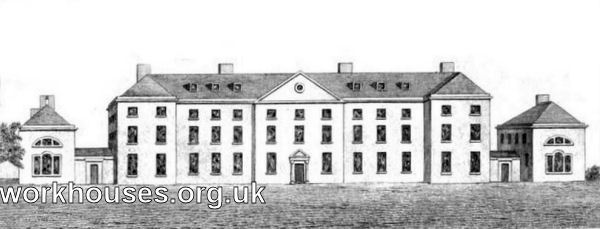
Shrewsbury Foundling Hospital, c.1779
Shrewsbury was the subject of an extensive report by Eden in his 1797 survey of the poor in England:
The bill of fare is to be as follows: Breakfast—Sunday, Thursday, broth; other days, milk porridge. Dinner—Sunday, Thursday, butcher's meat and garden stuff ; Monday, hasty pudding with butter and treacle sauce; Tuesday, Saturday, stewed meat with potatoes or other garden stuff ; Wednesday, bread and cheese ; Friday, yeast dumplins. Supper—Sunday, Wednesday, Thursday, Saturday, broth; Monday, Friday. mashed potatoes; Tuesday, pease soup. The amount allowed to be weighed by the steward. It was further ordered that the larder, kitchen and other offices, together with the utensils and furniture thereof be kept sweet, clean and decent, that the dining-hall tables and seats be cleaned immediately after each meal, as well as the dormitories, either before or after breakfast, when the windows are to be thrown open, and the doors locked. To avoid infectious distempers, every new inmate is to be carefully examined, washed, and if necessary clothed. Clean sheets are to be provided for the beds once a month, or oftener if necessary, and the inmates with clean linen once a Week. The inmates, except those disabled by age or other infirmities, are to take their meals together, and to work in the summer months from 6 in the morning to 6 at night (in winter from 7 to an hour to be fixed by the directors), with a break of half an hour for breakfast and an hour for dinner; but no work is to be required on Sundays, Good Friday, Christmas Day and the two following days, Monday and Tuesday in Easter and Whitsun weeks, on Shrewsbury Show day and on Saturday afternoons after 3 o'clock. Payment of one-sixth part of their week's work is made to all except in cases of misconduct, and punishments are given to all who profanely curse or swear, who appear to be in liquor, who are refractory or disobedient to the reasonable orders of the steward or matrons, who pretend sickness, make excuse to avoid working, destroy or spoil material or implements, or are guilty of lewd, immoral or disorderly behaviour.
The children are to be taught reading and other useful branches, and are to have their hands and faces washed and their hair combed every morning. The paupers in the house are chiefly employed in the woollen manufactory, in which they are instructed by proper persons versed in scribbling, cording, and spinning. Several weavers are constantly employed. Those who have been shoemakers, tailors, carpenters, etc., are set to work at their different occupations. The decent and orderly are in a great measure separated from the profligate and debauched, who are kept in distinct working rooms and dormitories. The treasurer, Mr. Wood, recommended that prostitutes and other abandoned females should be lodged in a detached building, but it is not known if this proposal has been adopted. Adjoining the house are two ranges of buildings, one of which contains apartments to which the Poor are sent on their admission to be stripped and washed, and infectious cases are dealt with till cured. One room is appropriated to fever. The other building is the infirmary, in which the sick and infirm are lodged in separate wards, according to their sex, under the care of proper nurses. Surgical cases are sent to the county infirmary, to which the directors subscribe. There is a grazing farm of 50 acres, with 20 cows, belonging to the house. The butter, except what little is used by the sick, is sold and produces about £70 a year; but the expenses of the farm are about equal to the receipts. There is an open contract for flour used in the house once a quarter, and a baker and a brewer are constantly employed. Prior to the opening of the house, the expenses of maintaining the Poor were £4,605 3s. 11d. for one year. The Poor's Rates were immediately reduced to £2,992 12s., at which sum they have continued. This sum, together with other receipts arising from the profit of the farm, compositions for bastardy and sale of manufactured goods, has been sufficient to defray all the expenses of the house. The Poor's Rate is now 2s. in the pound on the rack-rent. It is expected that a rise will soon be necessary. The number of paupers in the house is 389. As the directors do not grant out-pensions, the number of young and stout is, as might be expected, very considerable. This explains the greatness of the earnings. The expense of maintaining the Poor in the house in meat and drink alone is estimated at 22d. or 23d. a week for each person.
After 1834
The Shrewsbury Incorporation's local Act status made it immune from many of the provisions of the 1834 Poor Law Amendment Act and it maintained its independence until 1870. On 4th April, 1870, a new Shrewsbury Poor Law Union was declared comprising the parishes of Holy Cross and St Giles (2 guardians), Meole-Brace (1), St Alkmond (2), St Chad (5), St Julian (4), and St Mary (5). The union was very short-lived, however, and very soon afterwards, the Poor Law Board decided to amalgamated Shrewsbury with the adjacent Atcham Union to form a new Atcham and Shrewsbury Poor Law Union.
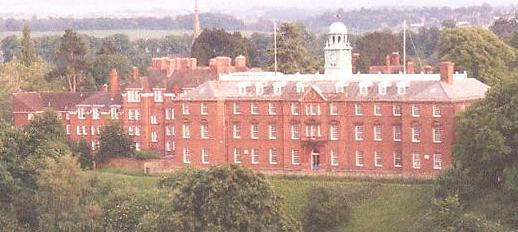
Former Shrewsbury Incorporation House of Industry.
© Richard Greenwell.
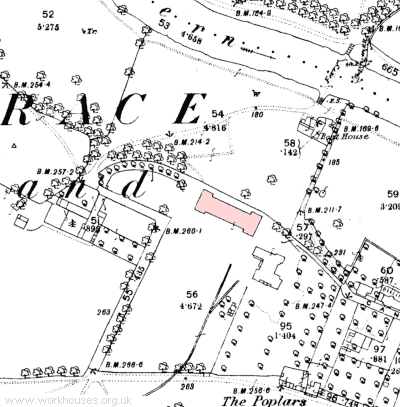
Shrewsbury former workhouse site, 1882.
After the Shrewsbury Incorporation was wound up, its former workhouse site was acquired by Shrewsbury School.
On 5 December 1905, a serious fire broke out in the building.
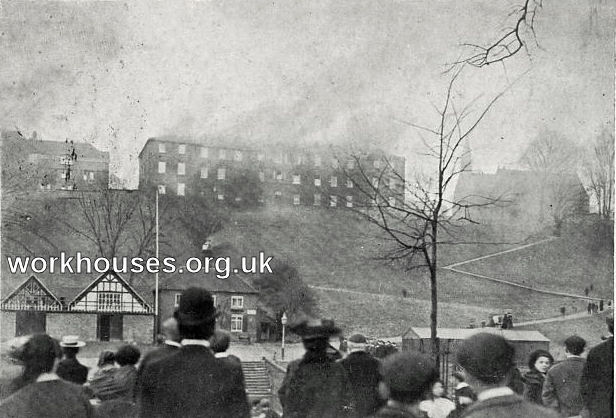
Shrewsbury School fire, 1905.
Shrewsbury's House of Industry has been the subject of a study by Richard Greenwell who has kindly contributed the following article on its history.
1784 - 1826, THE HOUSE OF INDUSTRY IN SHREWSBURY.
The Shrewsbury House of Industry opened officially in 1784, even though it had begun receiving paupers the previous year. It was established under a local act entitled 'An Act for the Better Relief of the Poor belonging to the several Parishes within the town of Shrewsbury and the Liberties thereof in the county of Salop.' Clearly inspired by the 'Gilbert Act' of 1782, the Shrewsbury Incorporation of six parishes followed the thinking behind that legislation, but was not in itself a 'Gilbert Union.' It had required around £6,000 capital to establish, and occupied the red-brick building constructed in 1765 for Captain Coram's Shrewsbury Foundling Hospital, in the Kingsland suburb of Shrewsbury. This institution had had only a brief history, closing around 1774. The building was subsequently used to house Dutch prisoners of war. There had been no workhouse in Shrewsbury for many years and the House of Industry was an attempt to reduce the financial burden on ratepayers caused by increasing out-relief. By gainfully employing the paupers, both within the House and in local industries, it was intended that poor-relief should become self-financing.
The underlying principle was that the poor should be encouraged into a habit of labour, and that this would accordingly reduce the immorality and social evils emanating from indolence. However, it was obvious from an early stage, that the directors intended that the workhouse should serve also as a deterrent to the claiming of relief, new claimants generally only receiving support inside the House itself. In the parish of Holy Cross, the number of those receiving out-relief fell from fourteen to four, between 1784 and 1786. (PL2/10/1/5). Illegitimacy was a great concern and fathers were sought to support their offspring, and accurate lists were drawn up. One Edward Corfield had to pay £14 in arrears. (PL2/3/5/1). The mothers concerned could only receive support in the House and were segregated from " those paupers that are the real objects of compassion" (PL2/2/1/1). Vagrants were rounded up and taken to the house "to suffer such corporal and other punishment as the directors shall inflict." Men, who abandoned their families leaving them chargeable to the parish, were "advertised in the newspaper with a 10 shilling reward for apprehending them." (PL2/2/1/1).
However, even though the regulation of poor-relief may appear somewhat draconian by modern standards, there were also sincere moral and welfare considerations evident in their implementation. The directors subscribed 5 guineas to the town's infirmary to allow its use by sickly paupers. Basic education was given in the House and emphasis was placed on the promotion of Christian ideals. Conditions within the House received much consideration, and, though primitive, were probably better than those experienced by paupers outside in the community. In 1808 Owen wrote of "the comfort of the new institution... and the mildness of its regulations...." (Owen, 1808:340). A great proponent of the House was Isaac Wood, a director between 1786 and 1789, and again between 1796 and 1799. The considered success of the House can also be assumed with the opening of similar incorporations locally, at Oswestry in 1790 and Atcham in 1792. Wood was a watchmaker and wrote a detailed description of the House of Industry in a pamphlet published in 1795, "Some Account of the Shrewsbury House of Industry...;" He describes the large red-brick building standing high above the town, separated from it by the River Severn. Entry was gained by ferry, followed by the steep climb up the bank. Upon admission, paupers were taken to a reception building, 'a bow shot away' from the main building, under the supervision of the nurse and apothecary, where they were washed and medically checked. They were later admitted to the main block where they were immediately segregated, men and women, boys and girls. Their day would start with the bell at 5.30am. and they would work from 6am. until 6pm. Prayers were said morning and evening in the Chapel. Three simple meals, usually of bread and broth, with occasional meat and cheese, were served in the large dining room 120 feet long with segregated tables. They slept in lofty, well-ventilated, and segregated dormitories also 120 feet long. Individuals were not allowed to leave the site without permission. In 1788, 250 of the 350 paupers worked six days a week, either in the manufactory, in tailoring or shoe-making, on the farm, in surrounding businesses, or in the House itself. Water for the House was hand pumped from the river by the paupers using a 'small machine'. Sunday was for worship in the Chapel, which was adjacent to the dining room. Ten days were regarded as holidays each year, including one for the Shrewsbury Show, which was then held on Kingsland. There was great emphasis on the training of the young to set a pattern for adulthood, children entering the spinning room at the age of five. The rules of the House were aimed at promoting 'honesty, sobriety, diligence, cleanliness and decency.' Inmates were allowed to keep just one-sixth of their earnings as a gratuity, if they were obedient. Good conduct was rewarded: three men and three boys were chosen to wear blue coats and three women and three girls were chosen to wear brown camblets, all embroidered with the words ' the reward of good conduct'. Punishments ranged from loss of gratuity to solitary confinement in the dungeon, from the stocks to corporal punishment. A gratuity of one shilling was also made on discharge, but of course many of the older paupers never left the House and were buried in unconsecrated ground adjacent to the sick house.
The 1782 'Act for the Better Relief and Employment of the Poor' had intended to make more profitable use of the pauper labour force for the benefit of industry and the whole nation's economy. It was the prime objective of the House of Industry that poor relief should become self-funding. To this end goods produced by paupers were sold for profit and paupers were hired out to local businesses. Foodstuffs were produced in-house and any surplus was again sold. The accounts of 1785/6 show that the system could have conceivably been successful. Payments, excluding interest and capital repayments, amounted to around £1,020, (in-house gratuities, out-relief and purchase of materials); while receipts totalled around £940, (from goods and farm produce sold, support for illegitimate children and from payments for hired out labour). This resulted in a deficit of only around £80. Clothing for all the resident paupers was made in the House manufactory and in 1788 the surplus was sold for a profit of £590. By 1790 the receipts for all manufactured goods had risen to over £2,000. By 1792 the farming account was in credit by over £145. A baker employed on the site made bread and beer, 20 cows were kept for dairy produce and pigs were kept for selling out at three months old. In 1796 a windmill was constructed to grind flour for the House, the surplus again being sold outside. Wood goes so far as to suggest that, in its first ten years, the House had saved ratepayers £16,000.
However, it would appear that the early years of its existence were those most successful for the House. In 1823, John Watton, editor of the Shrewsbury Chronicle, uncovered serious fraud, which had been going on since at least 1817. The Clerk and the Steward of the House, George Wellings and Richard Beacall, were both sent for trial in 1824 at Shrewsbury Assizes accused of embezzling money from the House. The actions taken by the new Clerk, Davies Owen Davies, suggest that the original objectives of the House were now far from being achieved. He took direct control over finances. He prohibited women from the mens' dormitories. All women that could be spared should wind yarn from 6am. to 6pm. and learn to read until 7pm. Vagrants were to be set to work instead of idly occupying the sick house and children were to start school an hour before breakfast in the interests of quiet in the house. Further, out-relief had again become a severe burden, costing over £30 each week, a figure four times that of 1784.
The poor publicity was to damage the reputation of the House. The Parishes began to complain that an unequal demand was being placed upon the system by individual parishes concerned in the incorporation. St. Chad's in particular complained that it paid nearly £1000, or half of House's budget, to support the 'paupers and bastards of the other parishes.' Accordingly, in July 1824 the directors agreed to seek the repeal of the act that had incorporated the parishes. They maintained that, at the embezzlement trial, the House had been 'pronounced by the Bench... to be ambiguous unintelligible and insecure... the experience of forty years having proved the impossibility of achieving the objectives.'
The final meeting of the directors was on 25th. September, 1826. It had been decided to retain the House as a workhouse for the town, under the management of Owen Davies, but much of its land was sold off. Control of finance was returned to the individual parishes that used it. No longer was it an autonomous organisation, it simply provided accommodation for the paupers sent by the parishes. Shrewsbury's experiment in poor relief was abandoned: no further attempts were made at self-sufficiency, nor were the paupers provided with any employment. It was under this regime that the workhouse was to continue until its eventual closure in 1871. The building was purchased by Shrewsbury School, then situated in what is now the public library in Castlegates. The internal structure of the workhouse was stripped out at this time, new windows were installed, and other embellishments, including the clock tower, were added under the supervision of Sir Arthur Blomfield. The School began its occupation in 1882, remaining to this day, parents paying handsomely for their boys to live in the once feared surroundings.
REFERENCES.
Weekly Payments Book, Holy Cross, 1784 -1792. Shropshire Records, PL2/10/1/5.Accounts with fathers of illegitimate children by surname. Shropshire Records, PL2/3/5/1.
Book of Orders, 1784 - 1808. Shropshire Records, PL2/2/1/1.
Owen, (1808) Some account of the ancient and present state of Shrewsbury. E.J.Morten: Manchester.
Wood, I. (1795) Some account of the Shrewsbury House
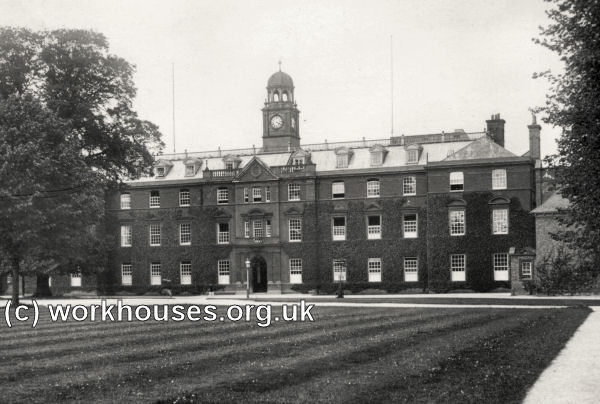
Shrewsbury former workhouse, c.1930
©Peter Higginbotham
Staff
- (To be added.)
Inmates
Records
Note: many repositories impose a closure period of up to 100 years for records identifying individuals. Before travelling a long distance, always check that the records you want to consult will be available.
- Shropshire Archives, Castle Gates, Shrewsbury, Shropshire SY1 2AQ. Please note that records may contain gaps or have access restrictions - please check before visiting. Extensive and varied records survive. Holdings include: General minutes (1784-1878); Workhouse administration minutes (1809-26); Admissions and discharges (1824-27, 1854-75); Indoor relief lists (1854-67, 1870-73); Births (1850-74); Deaths (181850-75); Creed registers (1870-75); Marriage notices (1837-71); Payments for bastard children (1784-1824); Workhouse medical relief books (1870-1); etc.
Bibliography
- (see above.)
Links
- None.
Unless otherwise indicated, this page () is copyright Peter Higginbotham. Contents may not be reproduced without permission.


